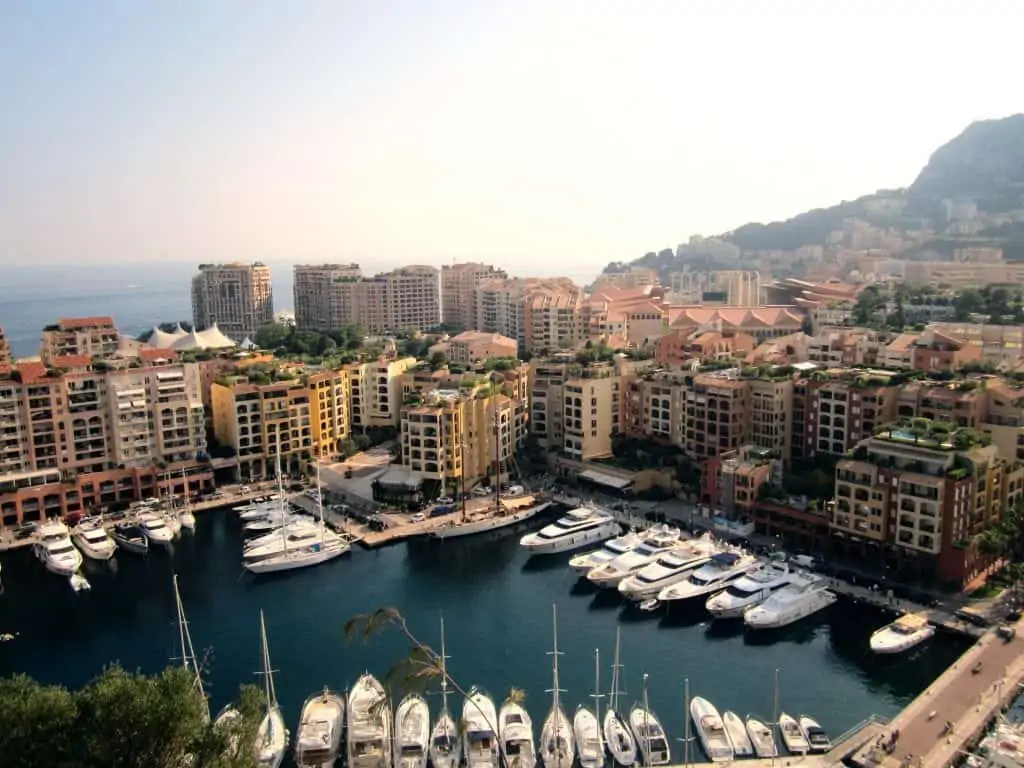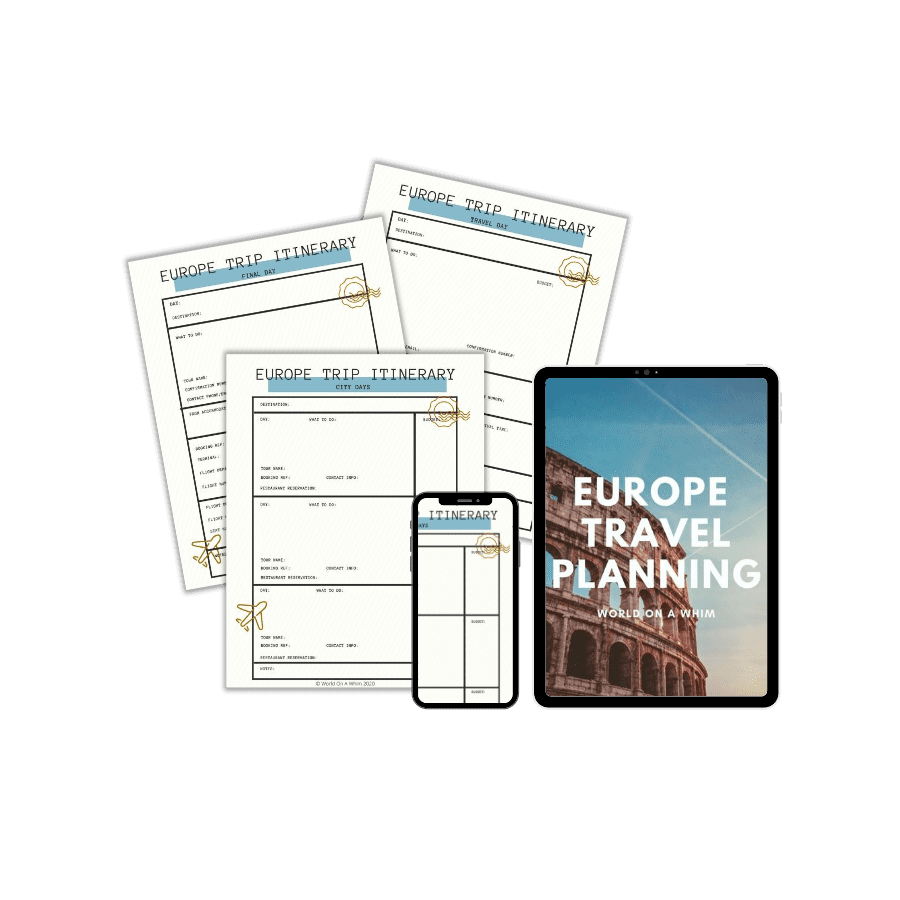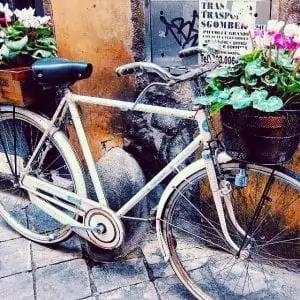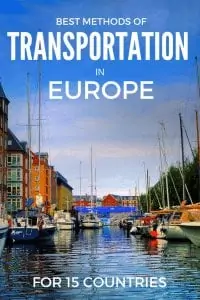Transportation in Europe: Best Methods for 15 Countries
January 20, 2020

Buses, Trains, Planes? Here are the Best Types of Transportation in Europe for 15 Different Countries
Traveling within European countries is actually quite simple. There is generally a vast network of trains, planes, buses, and ride shares to choose from and websites like Omio can relay all that information to you in one quick search. However, while booking engines might give you all the options for transport in Europe, it won’t explicitly tell you the best method for each country. That is why I created this list of 15 countries and the best mode of transportation in Europe within each country.
Europe Travel Planning
Are you traveling to Europe in 2020? Join the FREE Europe Travel Planning Facebook Group! If you have questions about your itinerary, need flight hacks, deals, or pre-departure checklists, then you'll fit right in! And, you'll get a free itinerary template when you subscribe to the ETP email list in the FB group!
This post contains affiliate links. That means I receive a small commission if you make a purchase after clicking the link at no extra cost to you.
Best Methods of Transportation in European Countries
Belgium:
The best way to travel within Belgium is by train. Tickets can be booked through the Belgian rail website. Cities such as Antwerp, Ghent, and Bruges are great spots for a day trip from Brussels and are accessible by train in under or around one hour. You can also travel quite easily from Paris to Brussels or Brussels to Amsterdam via train. Prices range from $50 to $150 last minute for economy class and are about 1 hour 20 minutes to 3 hours and 9 minutes in duration respectively. Check out the Rail Europe website for options.
Croatia:
In order to get from Zagreb to Split, Zadar, Plitvice Lakes or Istria, I recommend renting a car. Be sure to rent in advance as prices are high and supply is limited, even more so if you need to rent an automatic car. If for some reason you don’t book in advance, be sure to ask your hostel or hotel for a rental car recommendation. They will most likely have a partnership with a rental car company in the area and will hopefully be able to solidify a good deal for you. While renting a car provides you the most flexibility, there is the option of taking FlixBus. Any journey under 7 hours or so is reasonable…just make sure you download lots of podcasts to keep you occupied!
You will need to take a ferry from Split to Hvar Island, but take the catamaran from Hvar to Split, Korcula and Dubrovnik. It is possible to buy the ferry tickets online; however, the timetables seem to change without notice, so I recommend going to the Jadrolinija office at the port of Split to purchase tickets. Once you arrive in Hvar town, head to the port to pick up the tickets for the catamaran. If you wait until the end of your stay in Hvar to purchase tickets, there is a high probability that the tickets will be sold out especially during high season. The catamaran is about a 4.5 hour ride that stops back in Split, then heads to Korcula, and finally Dubrovnik.
Read More: Croatia: An Ideal 10-Day Itinerary
France:
Train travel in France is the most effective way of going from Paris to other cities in France. Here is the TGV (Train a Grande Vitesse) website you should use to book your travel. Travel from Paris to the south of France–albeit a bit pricey–is best done by train; airplane and train prices are typically comparable, but train travel is much less of a hassle. While traveling by bus or ride share is cheaper, the amount of hours it would take is just not practical.
Greece:
I suggest that you first fly to mainland Greece so you can see Athens for a couple of days. Is it even a trip to Greece if you don’t see the Acropolis? If you are heading north to Meteora, you should take the train, but if you are heading to the Greek islands, then a ferry or flight is your best bet. I have a whole in-depth article specifically about Greek Island hopping that I will link here. This post goes into extreme detail about which islands have airports, how the islands are grouped together, and also suggests feasible itineraries based upon the type of trip you are looking for. Ferries are tricky to plan around so make sure you look up the times before you decide on your itinerary. They are also notoriously delayed, so you must take that into account when booking flights and excursions. Blue Star ferries and Hellenic Seaways are popular companies, but be flexible and take whatever ferry is available that day at the best price and time available. Note: the ferry from Athens actually leaves out of a port called Piraeus so don’t be alarmed if you cannot find Athens as a departure port on the ferry website.
Read More: Greece: An Ideal 10-Day Itinerary
Italy:
Train travel is a fantastic means of transportation in Italy. In fact, train travel is so popular in Italy that you really don’t need to even plan ahead. I woke up in Milan one morning, walked over to the train station, and booked a train to Venice that left in 20 minutes. Just go to the Trenitalia website to get an idea of the train options before you book and at that point decide whether you want to purchase online or if you can simply go down to the train station and book in person. Also, while train travel is usually the way to go, FlixBus also has an incredible network of buses that work great for short distances. I always check Omio before I book anything; I put my arrival and departure city and compare train and bus options. Then, depending on price, time, and whether or not the bus or train station is located closer to my current location, I will make a decision on which is the best method of transport.
Hungary, Austria, Czech Republic:
The bus is the best mode of transport in Eastern Europe. To travel between cities like Budapest, Prague, and Vienna, I use either FlixBus or Student Agency Bus . Both buses leaves multiple times a day and Student Agency has amenities like leather seats and a stewardess who passes out hot drinks. These major cities also have trains running between them. You can go on the OBB website to book train travel between these three countries. Geographically, please note that Vienna (Wien when booking on the train website) is in the middle of Prague (Praha) and Budapest, so plan your itinerary accordingly if you can. Start in Budapest and go to Vienna and then Prague or start in Prague heading down through Vienna to Budapest. If you choose to fly to another city in Europe from one of these countries, be sure to check out the low cost airline Wizz Air for some good deals.
Germany:
Transportation between major cities like Berlin and Munich is a toss up when it comes to price. Trains, buses, and planes all make sense depending on what is the cheapest on the day you are traveling. Germany tends to be more expensive than most of the other countries on the Euro, and that is evident in transportation costs. If there is a reasonable flight between the two cities, you will probably be flying Eurowings and easyJet or Lufthansa which actually can have some reasonably priced flights. Trains in Germany sometimes have affordable pricing, although these are typically at offbeat times like overnight trains. You can search for options on the Deutsche Bahn website. Similarly, there are some decent FlixBus options; however, many of the options are 10/11 hours which, in my opinion, is too long to be on a bus. Make sure you choose one with zero changes if you can.
United Kingdom:
The preferred method of transportation to and from London is by plane. That’s because there are five airports in London—Heathrow, Stansted, Luton, City, and Gatwick—so there are a multitude of options for booking cheap flights. Be sure to check flights on easyjet, British Airways, Ryanair, and Flybe.
London to Paris: The quickest and most exciting way to get between these two major metropolitan cities is through the chunnel or “channel tunnel”. The Eurostar train is expensive; but, if you have some money to spare, the train ride itself is only two hours and is totally worth it. There is also a bus option, but expect the trip to be around eight hours. Bus companies include Eurolines, Ouibus, and FlixBus. Flights are another promising option as London has five airports to fly in and out of and Paris has two that are relatively close to the city center. If you do find a “cheap” flight, don’t forget to include how much it will take to get to the airport. The Gatwick Express is pretty pricey, so it may make more sense to take the Eurostar in the long run.
London to Dublin: If for some reason you decide not to fly between these two cities, you can take a ferry instead. Cleverly dubbed “sail and rail,” the train takes you to Holyhead, Wales and you would then take a ferry across the sea for about 1 hour and 40 minutes.
London to Edinburgh: Planes once again are your best option from traveling between these two locales as train tickets would be around 60 pounds for a one-way trip. You could also try to book two separate tickets; for example, London to York and then York to Edinburgh if you can get a great deal on one of the legs of the journey and if the timetables align properly. If you are trying to book flights just a couple of days before, you can get deals for as low as 40 pounds in the off season. You can also use National Express for very cheap transport options, but expect a 9-12 hour journey.
London to anywhere in England: Most Londoners take the train to all other cities in England whether that be Cambridge, Manchester, York, Bristol, etc. Here is a link to the website which will show you your best options. The National Express bus does also go to many cities in England, but expect the duration to be double or triple the amount of time it takes on the train. You can compare all of the available options on Omio.
Read More: 5 Days in London: An Ideal London Itinerary
Monaco:
You can walk around the region of Montecarlo quite easily although the terrain is a bit hilly. If the walk becomes too much, there is a public bus system that you can take. To go from the French Riviera to Monaco, you can use the French National Railway Company’s website to book a trip for around 10 euros. Just be careful to check the times of the last train leaving Montecarlo for the evening if you are taking a day trip as I almost missed the last one of the evening on my way back to Cannes!
Netherlands:
Train travel is the best method of transportation to get from one city to another in the Netherlands. Prices are relatively inexpensive as you can book a ticket through the NS website from Amsterdam to Rotterdam for about 15 euros and Amsterdam to the Hague (Den Haag Central) for around 11 euros. Explore each individual city in the Netherlands by riding a bike along the canals and through the many green spaces you’ll find throughout.
Portugal
Bus and train travel are the most efficient types of transport in Portugal. Difference in price is nominal, so I would suggest utilizing whichever form of transport is closest to your accommodation. Travel from Lisbon to Porto or Lisbon to Lagos will cost you about 20 to 30 euros. Buses can be booked on the Rede Expressos website. To book train travel, you can buy tickets on the Comboios de Portugal website or through Rail Europe. Trains depart from both Santa Apolonia and Oriente train stations; Santa Apolonia is the more central station whereas Oriente is closer to Lisbon airport. Make sure to include a day trip to Sintra during your time in Lisbon. Take the train from Rossio Station in Lisbon’s Baxia 40 minutes to Sintra station.
Spain:
I am a massive fan of bus transportation in Spain. In fact, I just completed a 2-week Northern Spain trip from coast to coast and utilized the bus system the entire way. Let’s just say that podcasts are my new best friend. Typically, I use the Alsa Bus for transportation around Spain. When traveling to the Spanish islands of Ibiza, Mallorca, or the Canary Islands, I typically fly Vueling or Ryanair. There is also a ferry to Ibiza and Mallorca from Valencia. If you are looking for convenience, then the high speed train called the Ave takes as little as 2 hours and 30 minutes to get from Barcelona to Madrid; however, you will be spending a minimum of $100. You can also utilize the train system –especially in Andalusia– by booking through the Renfe website.
Another transportation alternative is to utilize a ride share service during your time in Spain. BlaBlaCar, an online marketplace of carpooling, runs in many different European cities and is used quite regularly in Spain. The site connects drivers and passengers who are traveling similar routes who would like to carpool and share the cost of the journey. Similar to any booking platform, make sure you choose a driver with a substantial amount of positive reviews.
Read More: Spain Itinerary: 10 Days in Barcelona & Madrid
Switzerland:
Trains, trains, and only trains! To get between cities in Switzerland, go on the Swiss Federal Railways website and book through this site. While Switzerland itself is expensive, train travel is surprisingly reasonable. You can book a trip cross country from Geneva to Zurich for about 25 euros and it only takes two and a half hours. This continues to blow my mind every. single. time.
Have these forms of transportation worked for you? Are there any other forms of transportation in European countries that you wish to add? Please share in the comments below!
Are you on Pinterest? Pin these Transportation Tips for later!
Did you like this post? Please follow me on Facebook for more updates!






